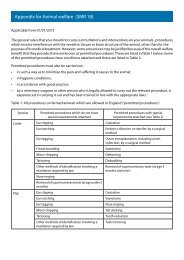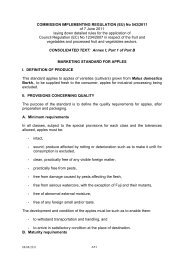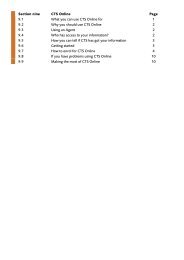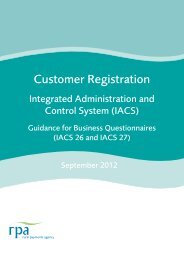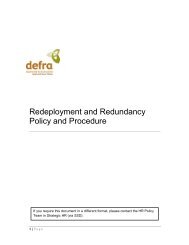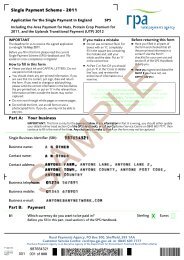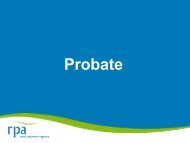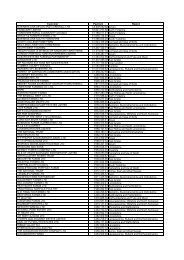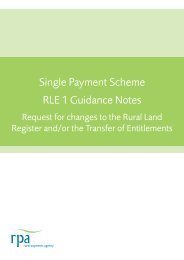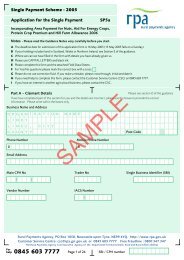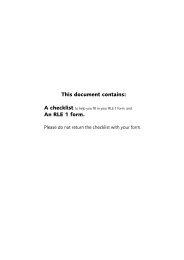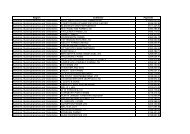Hill lFarm Allowance Explanatory Booklet.pdf - The Rural Payments ...
Hill lFarm Allowance Explanatory Booklet.pdf - The Rural Payments ...
Hill lFarm Allowance Explanatory Booklet.pdf - The Rural Payments ...
You also want an ePaper? Increase the reach of your titles
YUMPU automatically turns print PDFs into web optimized ePapers that Google loves.
<strong>Hill</strong> Farm <strong>Allowance</strong><strong>Explanatory</strong> <strong>Booklet</strong> 2007
RPA Customer Service Centre●Customer Service Centre<strong>Rural</strong> <strong>Payments</strong> AgencyPO Box 1058Newcastle-upon-TyneNE99 7YQTelephone: 0845 603 7777Email: csc@rpa.gsi.gov.ukLatest News for Applicants – Action Required1) Anyone wishing to claim for HFA 2007 must complete the declaration enclosed within yourbooklet pack and return it in the envelope provided by 19 January 2007. Further informationcan be found at section 2.2.Failure to respond will result in the application of late claim penalties to all claims made after19 January, but before 13 February 2007. Claims made after this date will not be considered.2) <strong>The</strong> mixed stocking enhancement, previously available to HFA applicants, will no longerbe available.3) From 1 January 2007, all applicants are required to follow cross-compliance across theirentire holding. Section 2.10 provides more detail.<strong>The</strong> <strong>Hill</strong> Farm <strong>Allowance</strong> 2007 is one of the schemes that will operate as part of the <strong>Rural</strong> DevelopmentProgramme for England (RDPE). <strong>The</strong> RDPE provides a framework of measure to safeguard and enhance ourrural environment (with Environmental Stewardship at the heart of the Programme) and foster competitiveand sustainable businesses and thriving rural communities.As at the date of publication of this booklet, the RDP Strategy Plan and Programme for England was stillbeing finalised. Further information about the programme can be found atwww.defra.gov.uk/erdp/rdp07_13Environmental Stewardship has 3 elements: Entry Level Stewardship, Organic Entry Level Stewardship andHigher Level Stewardship. <strong>The</strong>y replace the Environmentally Sensitive Areas scheme, the CountrysideStewardship Scheme and the Organic Farming Scheme. Further information can be obtained from NaturalEngland. Your local office can be located by calling 0845 600 3078 or at www.naturalengland.org.uk
ContentsPart 1: Introduction to the Scheme 2Part 2: Eligibility Requirements 3Part 3: Area <strong>Payments</strong> 8Part 4: Enhancement Criteria 10Part 5: General 11Annex A: Example Calculation 14Annex B: Legislation 18Annex C: Ineligible Cattle Breeds 19Annex D: Glossary of Terms 201
Part 1: Introduction to the Scheme1.1 What is the <strong>Hill</strong> Farm <strong>Allowance</strong>?<strong>Hill</strong> Farm <strong>Allowance</strong> (HFA) is a scheme which provides dedicated support to beef and sheep producers whofarm the English Less Favoured Areas (LFAs). It recognises the difficulties that farmers face in these regionsand the vital role that they play in maintaining the landscape and rural communities of the hills.<strong>The</strong> HFA aims to contribute to the maintenance of the social fabric in upland communities through supportfor continued agricultural land use. It also helps to preserve the farmed upland environment by ensuringthat land in the LFAs is managed in a sustainable way.HFA is administered by the <strong>Rural</strong> <strong>Payments</strong> Agency (RPA) on behalf of the Department for Environment,Food and <strong>Rural</strong> Affairs (Defra).1.2 What are the Less Favoured Areas?LFAs are areas where the characteristics such as geology, altitude and climate make it more difficult forfarmers to compete. LFAs are designated under European law. Maps designed to show the different landclassifications are available for viewing on-line at the following address:www.magic.gov.uk/default.htmLand coloured pink is severely disadvantaged, whilst the disadvantaged land is coloured blue.1.3 What is the HFA budget ?At the time of printing this document the overall budget allocation for the <strong>Rural</strong> Development Programmefor England had not been set. Indicative payment rates are given in section 3.1 based on the 2006 budget.We will publish the HFA 2007 payment rates as soon as we are able.1.4 When will the HFA be paid?<strong>The</strong> RPA are currently looking at next year’s payments for HFA. <strong>The</strong> timing of HFA payments in 2007 isdependent on SPS processing and the RPA has a target of making 96.14% of total value of SPS 2006payments by 30 June 2007. We expect to have a clearer picture on next year’s payments in the New Yearand will publish further information as soon as we are able.2
Part 2: Eligibility Requirements2.1 Who can claim HFA?To be eligible for HFA 2007, producers must meet all of the criteria set out below:●●●●●have a minimum of ten hectares of eligible LFA forage land (this may include a share of LFA CommonLand), which they have listed under column C14 of their SPS 2006 Field Data Sheets or, if they haveused the HFA 2007 Application form (HFA 007) under column B6;keep breeding sheep and/or breeding cows (which satisfy the relevant criteria, which are explainedat paragraph 2.6);stock at a minimum of 0.15 livestock units per hectare (LU/ha) (or less if they have an agrienvironmentor other agreement that restricts their stocking density further);undertake to keep at least ten hectares of land situated in a Less Favoured Area in agriculturalproduction, continuously, for five years, from the date of the first payment of LFA support.with effect from 1 January 2007, to follow cross compliance requirements, as set out in the CrossCompliance Handbook for England 2006 (an update for which, including changes for 2007, can beobtained from the RPA if you do not already have one).2.2 How do I claim HFA?As the structure and budget for the HFA in 2007 were not known at the time of the deadline for receipt ofSPS 2006 applications, applicants were instead asked to provide information as an indication of theirintention to claim HFA 2007.<strong>The</strong> information required was details of eligible livestock numbers and eligible land parcels. A declarationform is now being circulated to all applicants who have provided information to support a claim for HFA orwho meet some of the eligibility requirements outlined at Section 2.1 above.<strong>The</strong> declaration form requests formal acknowledgement of the need to comply with the scheme eligibilitycriteria and the wish to receive an HFA 2007 payment.3
<strong>Hill</strong> Farm <strong>Allowance</strong> <strong>Explanatory</strong> <strong>Booklet</strong>ACTION REQUIRED NOW – PLEASE COMPLETE AND RETURN THE DECLARATION FORM BY19 JANUARY 2007If you have not previously provided details of the eligible animals and land areas, please tick theappropriate option on the declaration and we will send you a blank HFA application form (HFA 007).Alternatively, a blank copy of the form can be downloaded from the RPA internet site, which can thenbe printed and submitted at the same time as the declaration.Please return this declaration to the RPA HFA Processing Team at the following address using thepre-addressed envelope provided:HFA,PO Box 23,Exeter,EX5 1WE.Details of eligible land and animal numbers should reach the RPA no later than 19 January 2007.Please allow enough time for us to return you a blank form and for you to submit it by 19 January2007. Please also return your completed declarations early, as we are unable to issue any reminders.2.3 What is eligible LFA forage area?Eligible LFA forage land is any land with a cover of either permanent or temporary grass, which is withinthe LFA boundaries and is available to be grazed or have a grass cut taken from it for a period of sevencontinuous months, starting between 1 January 2006 and 31 March 2006.In order for you to claim HFA on the land it must be available to you for four of the seven months,although the four months need not be consecutive. Where applicable, the ten hectares minimum mayinclude LFA common land.If your holding includes land in Wales, Scotland or Northern Ireland (the Devolved Administrations), anypayments due to that land will be dealt with by the Devolved Administrations.Land used for milk production is not eligible for HFA payment. <strong>The</strong>refore we will obtain details of any MilkQuota that you held on 31 March 2006, which will be used in determining the amount you are entitled tofor HFA 2007. See Annex A for an explanation of how this applies.Statements of Milk Quota should be checked to ensure that the correct amount of quota has beenattributed to the business. Failure to do so may complicate the processing of your application andultimately may result in recovery of any payments to which you are not entitled.42.4 How will my land be classified?<strong>The</strong> declared forage area from your SPS 2006 form will be divided into the following categories:●●land within the Moorland Line;other LFA common land;
<strong>Hill</strong> Farm <strong>Allowance</strong> <strong>Explanatory</strong> <strong>Booklet</strong>●●●other Severely Disadvantaged Area (SDA) land;other Disadvantaged Area (DA) land;non-LFA land (including non-LFA Common).<strong>The</strong> category of your land will be determined by the information held on the <strong>Rural</strong> Land Register.2.5 What is the Moorland Line?Land within the Moorland Line is predominantly semi-natural upland vegetation, used primarily for roughgrazing. <strong>The</strong> Moorland Line was drawn using Ordnance Survey mapped features such as walls, tracks orstreams. It was established in 1992 to assist the development, implementation and evaluation of policy inthe English Uplands.In 2004 an appeal process against the Moorland classification of land parcels took place to take account ofchanges since its establishment e.g. the land may have been improved for greater productivity. <strong>The</strong> AppealsProcess has now closed and no further representations will be considered. In February 2006 the revised setof maps were established.Contact your RPA CSC if you need more information about land within the Moorland Line. Maps showingthe Moorland Line are also available online, via the following address: www.magic.gov.uk/default.htm2.6 What are eligible cattle and/or sheep?<strong>The</strong> cattle that can be included for HFA are those that form part of a herd used for rearing calves for meatproduction only; dairy herds are not eligible. Cattle must be female and:●●●●●either be of a beef breed or be a crossbreed which is the offspring of a cross with at least one parentbeing a beef breed or a beef/dairy cross. A list of ineligible breeds is included at Annex C;must be entered into your records, which must comply with the Cattle Identification Regulations1998, be kept up to date, and be available for inspection;at least 60% of the cattle included in the stocking density calculation must have calved. <strong>The</strong> other40% can be made up of heifers over eight months old which have not calved. <strong>The</strong> number of heifersmust not exceed 40% of the total cattle included in the calculation;you must own, or have a formal leasing agreement, on the cattle included (which must be producedupon request) and also have economic responsibility for them;you must keep all the cattle on which you are claiming or their eligible replacements on your holdingfor a 6 calendar month retention period. For HFA 2007, the retention period can start from a datebetween 1 July 2006 and 31 December 2006.Any female sheep can be considered as long as they:●●formed part of a flock kept on the holding for any 100 consecutive days starting between 1 January2006 and 22 September 2006;were at least 12 months old or had given birth to a lamb by the end of that period;5
<strong>Hill</strong> Farm <strong>Allowance</strong> <strong>Explanatory</strong> <strong>Booklet</strong>●●were owned by you, or formed part of a formal agreement leasing them to you (which must beproduced upon request);were entered into your records which were compliant with the Sheep and Goat Identification andMovement Order (SAGRIMO), kept up to date and available for inspection.2.7 How will you work out if my claim meets the minimum stockingrate of 0.15 LU/ha?<strong>The</strong> calculations that we use to determine your stocking density are explained in Annex A.2.8 What happens if my stocking rate is below 0.15 LU/ha?We will write to you before rejection explaining what you should do. You may still be paid if you fall intoany of the following categories:●●●have additional animals on your holding which would bring you up to the minimum stocking rate.This may be the case if you did not declare all of your animal numbers;have an official agreement which commits you to maintain a low stocking rate. Agreements withDefra such as the new Environmental Stewardship schemes (OELS, ELS or HLS) or one of the existingEnvironmentally Sensitive Area (ESA) or Countryside Stewardship Scheme (CSS) agreements areincluded as are agri-environmental agreements with other official bodies (e.g. Natural England,National Parks, etc).have entered into the Compulsory Scrapie Flock Scheme (CSFS) and reduced your flock numbers asa consequence.If you have any other reason for having a low stocking density, please let RPA know and they will consideryour case individually.Please Note: In previous years we have been able to offer an exemption from the minimum stockingdensity requirements if you have been in receipt of Extensification Payment Scheme payments.Exceptionally, this exemption was rolled over for HFA 2006. This exemption will not be availablefrom HFA 2007 onwards.2.9 What is the maximum stocking density that I am allowed?<strong>The</strong>re is no maximum stocking rate. However, you are required to manage your land in line with crosscompliance requirements (see para. 2.10) and, therefore, should avoid overgrazing or unsuitablesupplementary feeding practices.6
<strong>Hill</strong> Farm <strong>Allowance</strong> <strong>Explanatory</strong> <strong>Booklet</strong>2.10 What other conditions must I meet?Up to, and including, 2006 there was a condition of receipt for HFA payments to adhere to Good FarmingPractice requirements.From 1 January 2007 you must adhere to the same cross compliance requirements as required by the SinglePayment Scheme, that is keeping your land in Good Agricultural and Environmental Condition (GAEC) andcomplying with a number of Statutory Management Requirements (SMRs). SMRs are specified legalrequirements relating to the environment, public health and plant health, animal health and welfare, andlivestock identification and tracing. Any confirmed breaches of cross compliance requirements may lead topenalties being applied to your HFA claim, plus your SPS 2006 claim and any other land based ruraldevelopment schemes that you are involved with. See the details of what is required in the SPS CrossCompliance Handbook for England 2006 and update, which contains details of requirements for 2007.Copies of the cross-compliance literature can be obtained from the RPA CSC, alternatively they can bedownloaded from the RPA website at the following address: http://www.rpa.gov.uk7
Part 3: Area <strong>Payments</strong>3.1 What are the payment rates?At the time of printing this document, the overall budget allocation for the <strong>Rural</strong> Development Programmefor England had not been set. <strong>The</strong> payment rates for 2006 are given below as an indication only.Payment rates for HFA 2007 will be set once the budget is known.●●●You will receive the full payment rates for your first 350 hectares of eligible LFA land.Land in excess of 350 hectares up to a maximum of 700 hectares will be paid at half rates.No payments will be made on land over 700 hectares.Rates – 20060-350 ha 351-700 haSeverely Disadvantaged (SDA) Land 30.82 15.41Disadvantaged (DA) Land 16.66 8.33Common Land/Moorland 11.66 5.83<strong>The</strong>se rates are purely indicative. We will publish rates for HFA 2007 as soon as we are able.3.2 Will you pay on land in such a way as to maximise the paymentthat I receive?Yes. Payment will be made in accordance with the payment rate and the hectarage limits outlined above,but the land will be paid upon in the following order:●●●SDA;DA;land within the Moorland Line and LFA common land.That is, we will pay on the land which attracts the highest rate of payment first when counting against thehectarage limits. <strong>The</strong> following 2007 example illustrates this:eligible LFA forage land = 900 ha area made up from:300 ha of SDA300 ha of DA300 ha of LFA Common Land.8
<strong>Hill</strong> Farm <strong>Allowance</strong> <strong>Explanatory</strong> <strong>Booklet</strong>Using the HFA 2006 payment rates and hectarage limits set out above, the area payment is calculated asfollows:Land Area (ha) Payment rate (£/ha) Payment (£)SDA 300 30.82 9,246.00DA 50 16.66 833.00DA 250 8.33 2,082.50LFA Common Land 100 5.66 566.00LFA Common Land 200 0 0Total 900 – 10,264.50A more comprehensive example can be seen in Annex A of this document.3.3 Will I be paid for my LFA common land?LFA common land will be eligible for payment at the same rate as land within the Moorland Line.<strong>The</strong> notional forage area of your common land will be calculated according to grazing rights allocatedto your SPS claim. Non-LFA common land is not eligible for payments.3.4 Why are the payments lower for land within the Moorland Line andLFA common land?<strong>The</strong> costs of sustainable farming of moorland and commons are generally less per hectare than elsewherein the LFAs. <strong>The</strong>re is a risk of over-compensating producers on large, low density, low input farms. <strong>The</strong>European Union regulation for rural development, under which HFA operates, specifically prohibits anyover-compensation.9
Part 4: Enhancement Criteria4.1 What are the enhancements?To ensure that HFA contributes to good environmental practice, payments will be increased for farmerswho can meet certain environmental criteria. You could receive a 5% or 10% increase on your basic HFAarea payment.4.2 When will payments be enhanced by 10%?Your basic payment will be increased by a minimum of 5% if you meet one of the following criteria or bya maximum of 10% if you meet both.●●maintain at least one hectare or 5% (whichever is the smaller) of the LFA area on your holding underarable cover that is not receiving other financial support and was not converted from permanentgrassland in or after 1999. We will calculate whether you meet this criterion based on the informationprovided on your Field Data Sheet. Please ensure that if you are supplying land parcel data for the firsttime on the HFA-only claim form that you use the correct codes in column B5 as appropriate;maintain at least one hectare or 5% (whichever is the smaller) of the LFA area on your holding underwoodland cover that is not receiving other woodland financial support and was not convertedfrom permanent grassland in or after 1999. We will calculate whether you meet this criterionbased on the information provided on your Field Data Sheet. Please ensure that if you are supplyingland parcel data for the first time on the HFA-only claim form that you use the correct codes incolumn B5 as appropriate.Please note that the mixed stocking enhancement, available under HFA 2006 to producers declaring botheligible breeding sheep and cows (and where at least 15% of the combined livestock units are cattle) isno longer available.A similar option existed in the Entry Level Scheme for lowland farmers which has now been extended toLFA farmers. <strong>The</strong>refore to avoid over-compensation (i.e. payments being received from two schemes forthe same activity) it has been removed from HFA 2007.10
Part 5: General5.1 How will payments be made?RPA’s preferred method of payment is by direct credit BACS (Bank Automated Clearing System) which is thequickest way of getting payment into your bank account. If you already receive grant and subsidypayments from RPA by direct credit, then payment under HFA will also be made by this method.5.2 Will there be any on-farm checks?We will check to make sure that you comply with the requirements of the scheme. You must allow us toinspect your forage area, to check your farm records, measure your land and count your animals at anyreasonable time. Inspection visits may occur without notice. If you refuse to allow an inspection, obstructan inspecting officer or fail to give reasonable assistance this will lead to a loss of payment and may giverise to prosecution. This is in line with Council Regulation 1698/2005.5.3 What is the legal basis of the scheme?<strong>The</strong> HFA scheme implements article 36a (ii) of (European) Council Regulation 1698/2005 and the relevantparts of articles 13–21 of Council Regulation 1257/1999. <strong>The</strong> detailed scheme rules are contained in theCommission Regulations covering Transitional Support, Controls and Implementation, together with the<strong>Rural</strong> Development Regulations under which the RDPE will be drawn up.At the time of writing only the Commission Regulation covering Transitional Support (1360/2005) iscurrently in place. <strong>The</strong> remaining regulations have been agreed but not yet published.<strong>Payments</strong> will be made under the <strong>Hill</strong> Farm <strong>Allowance</strong> Regulations 2007, although this too is currently indraft form. For the list of relevant legal provisions, please see Annex B.5.4 What if I have a complaint about RPA administration?If you are not happy with the way RPA has dealt with your payment, please contact the RPA CustomerService Centre (CSC), who will make sure that your complaint is investigated fully and that you receive anexplanation of their findings. If you are still unhappy with the outcome, you will be advised how to takeyour complaint further.5.5 Will details of my application be passed by RPA to anyone else?Your HFA payment is liable to income tax, therefore, should they request it, details of your payment may besupplied to the Inland Revenue. In addition, information from your application may be passed by the RPA,in confidence, to duly authorised agents for the purpose of verifying its accuracy, evaluating the scheme orto assist in wider areas of work within RPA’s interests.For example, if your 2006 SPS application contained any eligible forage area in Wales, Scotland or NorthernIreland (the Devolved Administrations), copies of your application will be forwarded to the relevantDevolved Administration.11
<strong>Hill</strong> Farm <strong>Allowance</strong> <strong>Explanatory</strong> <strong>Booklet</strong>5.6 Will any penalties be applied?Applicants wishing to claim HFA 2007 must complete and return a declaration that formally signs them upto the conditions of the scheme. This declaration must be returned by 19 January 2007.Please be aware that any declarations received after the 19 January 2007 will be subject to late claimpenalties (reduction of 1% per working day in the amount you would have received based on the validatedLFA land declared on your application form in column C14 of the SP5 or B6 of the HFA 007). Lateapplications can only be submitted up to 25 calendar days late and the final cut off date is the 13 February.HFA payments will be based on eligible forage area after account has been taken of any penalties appliedas a result of overdeclaration of the land area (full details of area penalties are given in the SPS explanatorybooklet) which can be obtained from the RPA CSC. Where those receiving HFA are subsequently found tohave made a false declaration for this or related RDPE schemes as a result of serious negligence they will bedisqualified for the calendar year in question. Where it is found that a false declaration has been madeintentionally the disqualification period will extend to the following year.Non-compliance with cross compliance requirements and/or other scheme rules could result in theimposition of penalties against your claim. <strong>The</strong> size of the penalty applied will be determined by the degreeof non-compliance, with the intention of deterring any further infringement.5.7 What happens if an overpayment is made?If you have an outstanding overpayment in respect of HFA or any other scheme, the overpayment may beoffset against your HFA payment. If you have any queries about repaying an overpayment that has beennotified to you, please contact the RPA Debt Recovery Unit in Reading.<strong>The</strong>ir address is:PO Box 69,Reading,RG1 3YDTelephone number: 0118 9531775E-mail: debtrecovery@rpa.gsi.gov.uk12
<strong>Hill</strong> Farm <strong>Allowance</strong> <strong>Explanatory</strong> <strong>Booklet</strong>If you are repaying an overpayment, your cheque should be crossed and made payable to ‘RPA’ and sent tothe cashier at the above address. Please quote your vendor number/Single Business Identifier (SBI) numberon the back of the cheque. Payment can be made directly to our bank account should you wish, providedthat you remember to quote your vendor number on the reverse of the cheque, to ensure that payment iscorrectly attributed. Our bankers are Lloyds-TSB, in Market Place, Reading.Our account details are:Sort code: 30-96-96Account number: 00926997Account name: <strong>Rural</strong> <strong>Payments</strong> AgencyIf you are to repay an overpayment, you should be aware that you may be required to pay interest on thatmoney. Interest will be calculated from the date of the letter informing you of the overpayment to the datethat the debt is cleared. <strong>The</strong> amount of interest applicable will be calculated by RPA Finance and notified toyou, again by letter.13
Annex A: Example CalculationWe will use information supplied on your SPS claim form about animals kept and information as to MilkQuota held on 31 March 2006, to determine your HFA 2007 stocking density.1. Start with forage areaWe will start with the total forage area declared on your SPS 2006 form, including non-LFA forage area andcommon land.2. Remove land used to support dairy farmingWe will then remove land notionally used to maintain dairy production as this land is specifically excludedfrom HFA payments. We will take the Milk Quota you held on 31 March 2006 and convert it to livestockunits (LUs) at a rate of 5.9 tonnes = 1 LU. This will be calculated to three decimal places.We will assume, where you have declared that you have non-LFA land that your dairy cattle are maintainedon that land. Using a stocking rate of 1.8 LU/ha for non-LFA forage area and 1.0 LU/ha for non-LFAcommons, we will calculate how much non-LFA land is needed to support the dairy herd, and remove itfrom the total forage area. If there is not enough non-LFA land to accommodate the whole herd, we willcalculate how much DA land is used for the dairy herd using a stocking rate of 1.4 LU/ha. This land will alsobe removed from the total forage area. In the unlikely event that there are still dairy units remaining, wewill then calculate how much SDA land they use, using a stocking rate of 1.4 LU/ha, and if necessary howmuch LFA commons or moorland using a stocking rate of 1.0 LU/ha. This land will also be removed fromthe total forage area. <strong>The</strong> amount of LFA land remaining after these adjustments will be used to calculateyour stocking density, to see if it falls below 0.15 LU/ha.3. Calculation of animal numbersWe will take the number of sheep declared on the HFA section of your SPS form in 2006 and convert it tolivestock units; An eligible ewe = 0.15 LU each.We will also take the number of cattle declared on your SPS form in 2006 and convert it to livestock unitsat the following rates:A suckler cow, or heifer over two years old = 1.0 LUWe will add the sheep and cattle figures together to give the number of LUs used in the calculation. Detailsof heifers are not asked for on the form and will only be requested if the older cows do not satisfy thestocking density requirement. A heifer aged up to two years on the first day of the retention period will beequal to 0.6 LU.14
<strong>Hill</strong> Farm <strong>Allowance</strong> <strong>Explanatory</strong> <strong>Booklet</strong>4. Final stageWe will assume that any remaining non-LFA land is stocked at a rate of 1.8 LU/ha and non-LFA commonland at 1.0 LU/ha. We will calculate how many LUs are maintained on the non-LFA land and subtract themfrom the number of suckler cow and sheep LUs already calculated. We will then divide the remainingnumber of livestock units by the remaining LFA forage area to give the stocking rate for your holding.5. What will be done with this stocking rate?If your HFA stocking density is below 0.15 LU/ha, then further information is required to establish eligibility.Details of the land area, declared animals and Milk Quota data that we have for your holding will be sentto you. You will be asked to provide one of the following:●●●details of additional animals (including heifers between eight months and two years old) which youhave not previously declared on your SPS form and which satisfy the eligibility criteria. For additionaleligible sheep to be considered for HFA they must have been on your holding for a retention period of100 consecutive days starting between 1 January 2006 and 22 September 2006. For eligible cattle tobe considered, they must have been kept for a six month retention period starting from any datebetween 1 July 2006 and 31 December 2006;you may maintain a low stocking rate as the result of an official environmental agreement. If this isa Defra scheme we will just ask you which one but if it is administered by anyone else, such as theCounty Council, we would like a copy of the agreement signed by both parties.have entered into the Compulsory Scrapie Flock Scheme (CSFS) and reduced your flock numbers as aconsequence.15
<strong>Hill</strong> Farm <strong>Allowance</strong> <strong>Explanatory</strong> <strong>Booklet</strong>Calculating Stocking Density – a worked example<strong>The</strong> box below provides an example of claimed details and how these would be used to calculatestocking density.Non-LFA forageNon-LFA CommonsSeverely Disadvantaged LandDisadvantaged LandMoorlandLFA CommonsMilk Quota150 ha0 ha75 ha50 ha25 ha0 haSuckler Cows 170Ewes 571,029.670 tonnes1. Convert the Milk Quota to Livestock Units via the following formula for average yield:5.9 tonnes = 1 LU,Milk Quota Held/Average Yield = Livestock Units,=> 1,029.670 / 5.9 = 174.520 LUs<strong>The</strong> milk quota therefore works out as 174.52 LUs.2. To work out how many livestock units will be maintained on your Non-LFA forage, you will need tomultiply the total amount of Non-LFA forage by a stocking rate of 1.8:Non-LFA Forage Area x Non-LFA Stocking Rate = LU maintained on Non-LFA forage,=> 150 x 1.8 = 270 LU3. Deducting your Milk Quota from this total will leave the remaining amount of Non-LFA LivestockUnits:Remaining Non-LFA LUs – Milk Quota LUs,=> 270 – 174.520 = 95.48 LUs16
<strong>Hill</strong> Farm <strong>Allowance</strong> <strong>Explanatory</strong> <strong>Booklet</strong>4. <strong>The</strong> remaining amount of Non-LFA forage land will then be populated with some of your sucklercows and/or sheep. Your animal numbers then require conversion to Livestock Units with theremaining figure for Non-LFA Livestock Units being subtracted from the animal conversion total.As one suckler cow is equivalent to one Livestock Unit, it may be simpler to subtract your remainingamount of Non-LFA Livestock Units from your equivalent amount of breeding cow Livestock Units:1 cow = 1.0 Livestock Unit,=> 170 x 1.0 = 170Cow Livestock Units Remaining – Remaining Non-LFA Livestock Units,=> 170 – 95.48 = 74.52 LUs5. You then need to convert your sheep into Livestock Units:1 Sheep = 0.15 Livestock Units,Sheep Numbers x Sheep to Livestock Units conversion factor,=> 57 x 0.15 = 8.556. Now add your sheep Livestock Units to the remaining Livestock Units from your suckler cows:Sheep Livestock Units + Cow Livestock Units,=> 8.55 + 74.52 = 83.077. Finally, to work out the stocking density on your Less Favoured Area land you need to add up all yourLFA land areas and divide your livestock Units total by the total amount of LFA:SDA + DA + Moorland = Total LFA,75 + 50 + 25 = 150 ha. of LFAStocking Density = Livestock Units (after disposal of Non-LFA Land) /Total LFA Area,83.07/150 = 0.55 LU/ha. = Stocking Density.17
Annex B: LegislationRegulation numberDescription1257/1999 Council Regulation setting out the framework for <strong>Rural</strong> Development1698/2005 Council Regulation setting out the framework for <strong>Rural</strong> Development, which partiallyrepeals Council Reg. 1257/19991782/2003 Council Regulation setting out the framework for the Integrated Administration andControl System and Single Payment Scheme1320/2006 Commission Regulation setting out the rules for transition to the rural developmentsupport provided for in Council Regulation 1698/2005DraftDraftCommission Regulation setting out the detailed rules for the application of CouncilReg. 1698/2005Commission Regulation setting out the detailed rules for the implementation ofCouncil Reg. 1698/2005, as regards the implementation of the control procedures aswell as cross-compliance in respect of rural development support measures795/2004 Commission Regulation setting out the detailed rules for the Single Payment Scheme796/2004 Commission Regulation setting out the detailed rules for the integration of IACS(Integrated System) & Cross ComplianceDomestic provisionsDraftSI 1998/871SI 1998/1339SI 2005/3100SI 2005/3459SI 2006/1538SI 2006/1539DescriptionStatutory Instrument setting out the RDPE Enforcement RegulationStatutory Instrument setting out the Cattle Identification RegulationsStatutory Instrument setting out the Cattle Identification (Amendment) RegulationsStatutory Instrument setting out <strong>The</strong> Sheep and Goats (Records, Identification andMovement) (England) Order 2005Statutory Instrument setting out the Common Agricultural Policy Single Payment andSupport Schemes (Cross-compliance) (England) RegulationsStatutory Instrument setting out the Cattle Identification (Amendment) RegulationsStatutory instrument setting out the Cattle Database (Amendment) RegulationsAn effective Statutory Instrument will be in force for HFA 2007.18
Annex C: Ineligible Cattle Breeds●●●●●●●●●●●●●●Angler Rotvieh (Angein) – Rød dansk mælkerace (RDM)AyrshireArmoricaineBretonne Pie-NoireFriesians: Fries Holland (FH), Française frisonne pie noire (FFPN), British Friesian, Friesian-Holstein,Holstein, Black and White Friesian, Red and White Friesian, Frisona Italiana, Frisona Espanola,Zwartbonten van België/Pienoire de Belgique, Sortbroget dansk mælkerace (SDM), DeutscheSchwarzbunte, Schwarzbunte Milchrasse (SMR)Groninger BlaarkopGuernseyJerseyMalkekorthornReggianaValdostana NeraItasuomenkarjaLansisuomenkarjaPohjoissuomenkarja19
Annex D: Glossary of TermsBACSBreeding cowBreeding sheepDefraELSHFAhaHLSLFAOELSRDPERPASPSBank Automated Clearing SystemA female animal 12 months old or over, of either a beef or beef-cross breed,which on the first day of retention has borne a calf, and which forms part of aregular breeding herd used for rearing calves for meat.A female animal, which has lambed by the start of the one hundred dayconsecutive period, and which forms part of a regular breeding flock used forrearing lambs.Department for Environment, Food and <strong>Rural</strong> AffairsEntry Level Scheme<strong>Hill</strong> Farm <strong>Allowance</strong>HectareHigher Level SchemeLess Favoured AreaOrganic Entry Level Scheme<strong>Rural</strong> Development Programme for England<strong>Rural</strong> <strong>Payments</strong> AgencySingle Payment Scheme20
Cover photographs provided byRobert Goodison, David Glaves,David Keys and Julien Sclater.Department for Environment, Food and <strong>Rural</strong> AffairsNobel House17 Smith SquareLondon SW1P 3JRTelephone: 020 7238 6000Website: www.defra.gov.uk© Crown copyright 2006Published by Department for Environment, Food and <strong>Rural</strong> Affairs.Printed in the UK, December 2006, on material that contains 100% recycled fibrefor uncoated paper or a minimum of 75% recycled fibre for coated paper.PB12118



